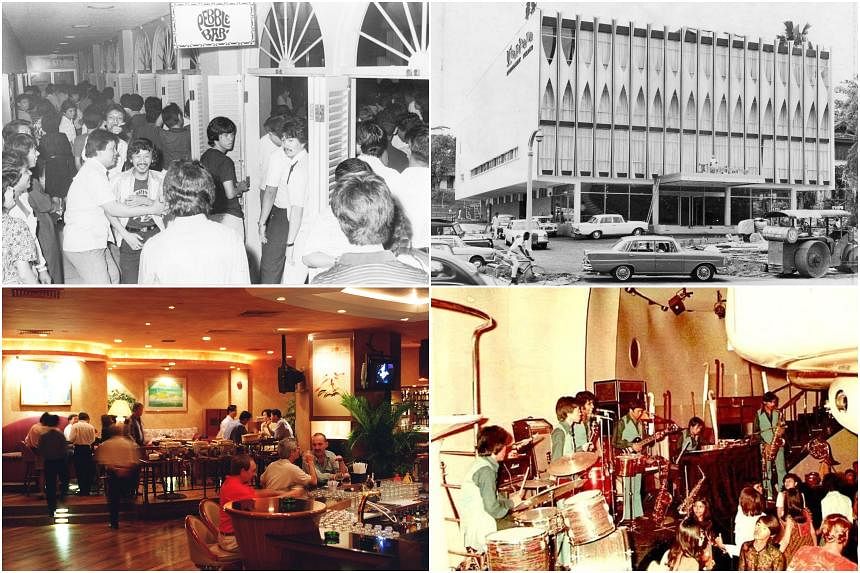Pebble Bar (1963)
Pebble Bar, which was also known as Pebbles Bar, opened in 1963 at the Singapura Forum Hotel, the site of the current Forum The Shopping Mall.
The hotel was the first local hospitality venture by the late property tycoon Ng Teng Fong, who founded Far East Organization in 1960. It cost Mr Ng $5.5 million to build the hotel then.
Besides being the first local hotel to be managed by an international hotel chain, the InterContinental Hotels Group, it was also the first to open a 24-hour coffee shop.
Pebble Bar initially attracted British residents, as well as foreign businessmen staying at the hotel, but later became a vibrant live-performance venue dominated by local band Tania in the mid-1970s.
Fronted by Zul Sutan with flamboyant vocalist Alban de Souza, and supported by bandmates such as bassist Ibrahim Zainal, Tania painted their faces with glitter dust like American band Kiss and performed chart toppers to a packed venue every night.

In the mid-1980s, the band moved to Anywhere Music Pub at Tanglin Shopping Centre after the hotel changed ownership.
Mr Ng sold the hotel in 1982 for $178 million to Dubai-based businessman A.W. Galadari. It was then acquired by Al-Khaleej Investments, which demolished the building and built Forum Galleria mall. It was later sold and renamed Forum The Shopping Mall.
Tropicana (1968)
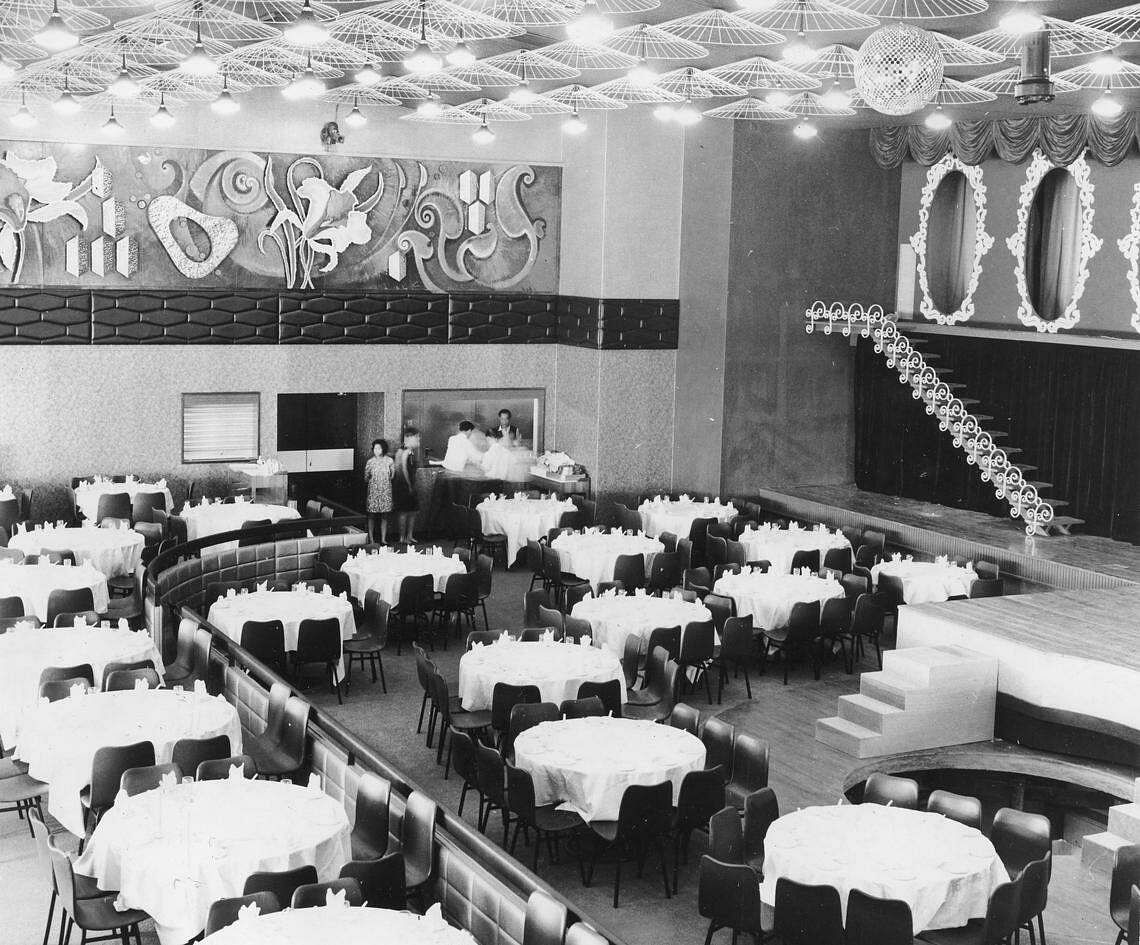
Construction of the first entertainment complex in Singapore and the region started in April 1967 on a 25,000 sq ft plot of land at 9 Scotts Road, where Pacific Plaza currently stands.
Called Tropicana, the four-storey air-conditioned building designed by Kee Yeap Associates housed many attractions, notably an 18m-wide stage that could slide, be elevated and revolve to enhance the performances of topless revues flown in from Europe and Asia. It cost about $1.75 million to build and another $1 million to equip the complex then.
Owner Shaw Sung Ching commissioned Mr Will Fernandez from Manila in the Philippines to create “first-class interiors” for the building. There was wall-to-wall carpeting, opulent chandeliers and a rock garden with a wall fountain. Tropicana employed about 130 people when it opened in 1968.

On the ground floor was the Orchid Lantern Chinese restaurant and nightclub with a mainly Cantonese menu, which could seat up to 500 diners and clubgoers. The restaurant was carved into different levels to provide diners with an uninterrupted view of the late-evening topless shows.
There was also a 200-seat Rasa Sayang restaurant, which served European and Indonesian cuisines, and the Le Bistro cocktail bar and private lounge.
By early 1989, Tropicana’s novelty faded, with increasing competition from shinier and newer nightclubs and discos. It was sold to Hong Kong-listed company London & Edinburgh Trust Pacific for $70 million.
Barbarella (1970)

It was billed as an “experiotheque” with a dance floor that was split into three levels, space age decor and 24 psychedelic slide projectors.
Barbarella opened at Ming Court Hotel in 1970 during a time when disco fever was on the cusp of becoming a worldwide phenomenon that dominated the 1970s and 1980s. As more discos opened, Barbarella upped the ante with a $300,000 revamp to get more people onto its dance floor and explore its futuristic interiors that were inspired by the hit 1968 Hollywood movie Barbarella, starring Jane Fonda.
Mr Jerry Fernandez, frontman of The Neu Faces – a six-piece local band that played six nights a week at Barbarella – remembers the glitzy interiors.
“It was a really glamorous place to be, with locals and foreigners jostling for space to jive on the split dance floor that looked like it was out of the set of the movie Barbarella,” recalls Mr Fernandez, 74, a proud grandfather of two grandchildren and who recently celebrated 50 years in show business with four of his bandmates.
“Barbarella was known for its buzz, sassy decor and sophisticated disco sound system.”
Crowds queued to get in to catch big names in the music industry, such as The Pitiful Souls, a five-piece British vocal group who wore white suits and toured Europe, the Middle East and Japan.
In June 1977, The Straits Times reported that Barbarella was slated to close in December that year.
The report said that business was poor at the disco since its reopening in 1976 after three years of being shuttered. In 1973, Barbarella was ordered to shut down, along with five other discos, by the Government because they were found to be popular haunts for drug addicts and traffickers.
Xanadu In Shangri-La (1981)
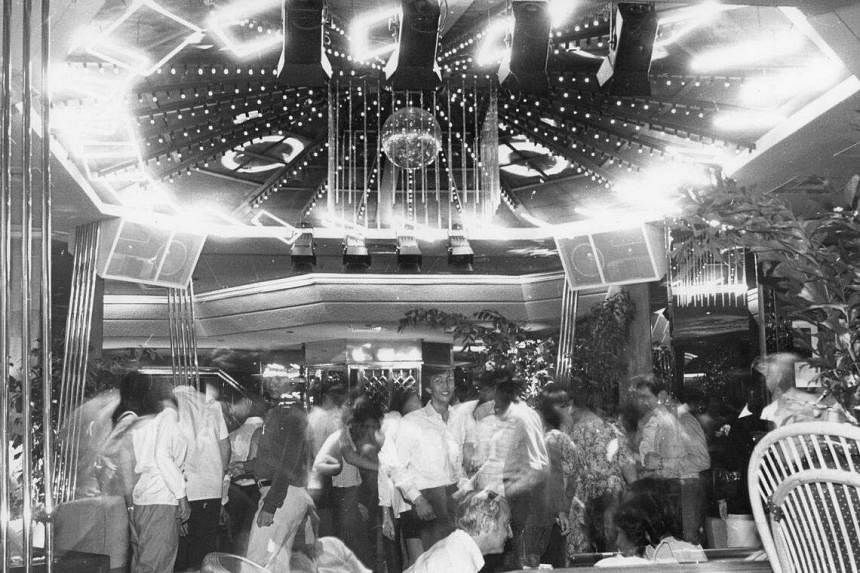
When Shangri-La Hotel opened in April 1971, it also unveiled Lost Horizon nightclub, which had an upbeat nautical theme and played soul, jazz and top hits. It was relaunched as Xanadu in 1981, and went through further revamps in its concept and refurbishments to keep the tills ringing.
Its most talked-about makeover was in May 1995, when nightlife veteran Dennis Foo, owner of entertainment company Europa Holdings, partnered Shangri-La to manage Xanadu. At the time, Mr Foo was known as the show business wunderkind who had the “secret sauce” for making nightspots turn in a profit.
He had opened six nightspots in Orchard Road by the mid-1990s, including Ridley’s at ANA Hotel in 1992 and Pleasuredome at Phoenix Hotel in the late 1990s. He also believed Orchard Road should be the beating heart of the nightlife scene in Singapore.
After Mr Foo and his team took over Xanadu, crowds snaked around the block and in just a few months, the disco’s takings multiplied almost 10 times. In 1997, Europa terminated the arrangement with Shangri-La, and the hotel resumed management of Xanadu.
Xanadu closed in the late 1990s as partygoers looked for more novel nightlife offerings away from Orchard Road.
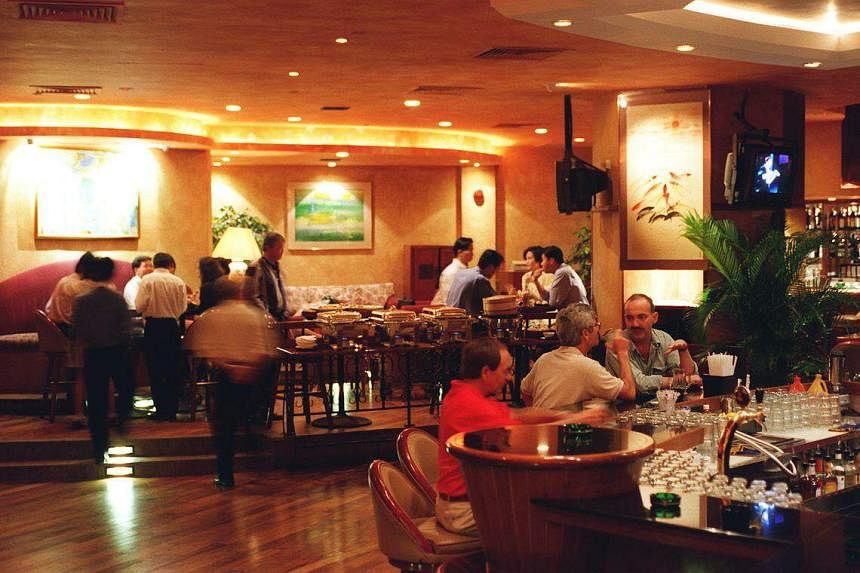
Mr Foo, 71, who has since retired, says Orchard Road needs to find its party groove again.
“I remember nightlife in Orchard Road was dead in the late 1980s and early 1990s,” he recalls. “A feature in The Straits Times in the 1990s titled I Will Take Orchard Road spurred me to do just that and we landed up with six top venues in the heart of the tourist belt.”
He says the decade prior to 2020, when the Covid-19 pandemic struck, had seen the growth of major nightlife destinations such as Clarke Quay, St James Power Station and dance venues such as Marquee at Marina Bay Sands.
“Now that the big players in nightlife have disbanded, Orchard Road, with all its prerequisites for a premier nightlife draw, should make its comeback.”
Top Ten (1985)
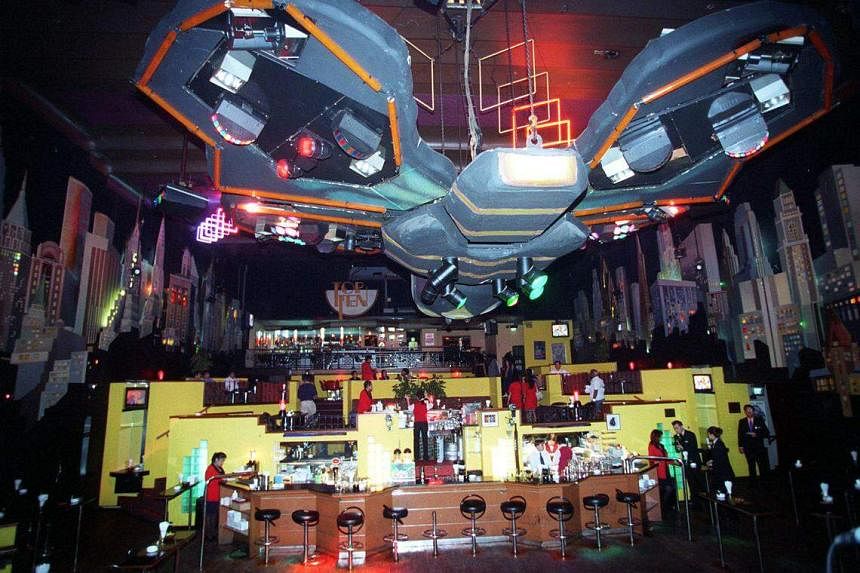
One of Singapore’s most successful nightspots, Top Ten opened in 1985 at Orchard Towers, and was a hit with locals and tourists for its three-storey-high ceiling and replica of a city skyline illuminated on its walls.
Owned and managed by Swiss-born Singapore permanent resident Peter Bader, Top Ten treated clubgoers to live performances from world-class acts such as 1980s American soul and disco stars The Three Degrees, the Commodores and Chaka Khan, as well as Puerto Rican chart-topper Jose Feliciano.
It also provided a platform for talented home-grown entertainer-deejays, such as Moe Alkaff who teased, cajoled and danced onstage, as well as played Billboard Top 10 hits, till the club closed at about 2am daily.

Top Ten was awarded the Singapore Tourist Promotion Board’s Tourism Award for Best Night Entertainment in 1987.
It shuttered in November 2005. At the time, there was intense competition from newer clubs. By then, alternative venues for international acts had sprung up – mega shows started to be staged at the Singapore Indoor Stadium since the late 1980s.
